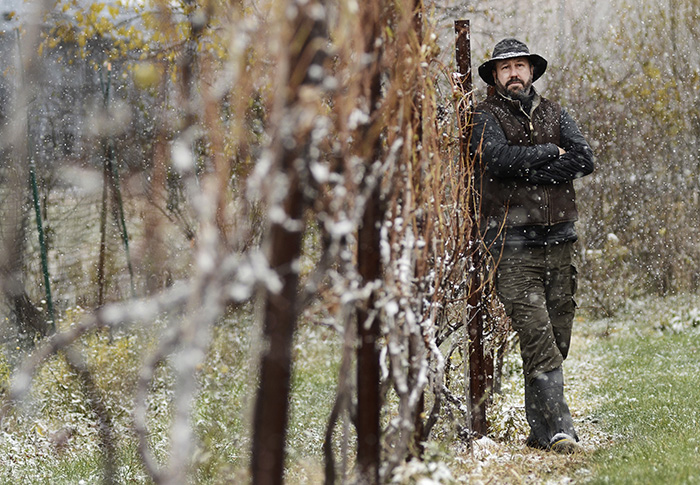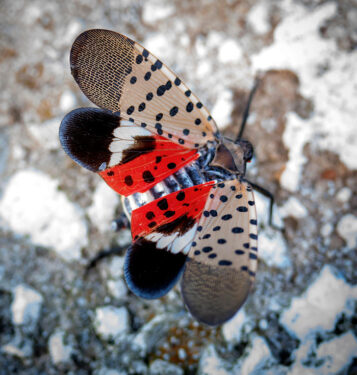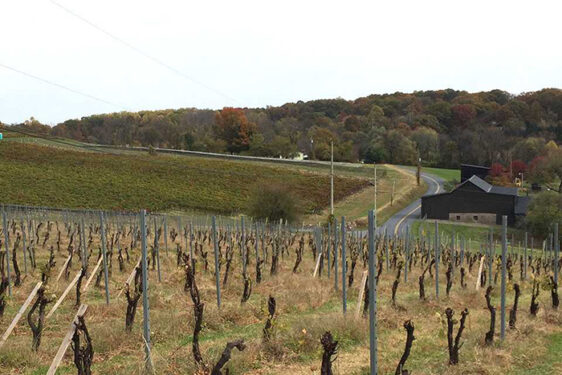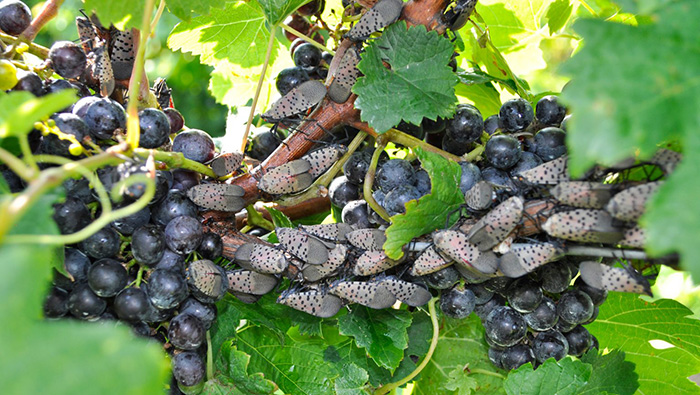
PROSPECT HEIGHTS — It is an understatement to say Will Ouweleen, a vintner in the Finger Lakes Region, is on the lookout for the spotted lanternfly.
He’s actually on high alert.
Ouweleen, of O-Neh-Da Vineyards in Conesus, specializes in sacramental wine used in the Eucharist. His customers include parishes throughout the Diocese of Brooklyn.
That all could change with a major infestation of spotted lanternflies.
This colorful yet voracious invasive species, native to China, made its first U.S. appearance in 2014. That was in Pennsylvania, where the sap-sucking fly was soon blamed for the demise of trees and vineyards.
The Finger Lakes region has recorded several sightings of the fly since last year but no significant infestations. Still, Ouweleen fears his area could be the next target.
“It’s going to be an existential threat,” Ouweleen said, adding that the danger “threatens the very existence of the Eucharistic celebration.”
If Ouweleen sounds like an alarmist, consider that he calls his operation the “only dedicated sacramental wine vineyard in the U.S.”
Bishop Bernard McQuaid of Rochester founded the winery 150 years ago as a reliable source of sacramental wine for parishes.
According to Ouweleen, O-Neh-Da’s customers in Brooklyn include St. Catherine of Genoa Parish; the Monastery of the Precious Blood and St. Edith Stein Monastery; St. Joseph College Campus Ministry; Our Lady of Angels Parish; and Our Lady of Lebanon Maronite Cathedral.
It also provides sacramental wine to St. Joseph Seminary and College at Dunwoodie, Yonkers.
“We’re the oldest sacramental winery in America,” Ouweleen said. “There are other brands out there, but they don’t grow their own grapes and make their wine. We do the whole thing. And we’ve been at it since 1872.”

Canon Law (No. 924) calls for sacramental wine that is “natural from the fruit of the vine and not spoiled.” Therefore, Ouweleen can’t use additives like extra yeast, coloring, corn syrup, or flavoring. Also, he can’t use insecticides — even if one eventually becomes available that could kill spotted lanternflies.
On top of that, the bug has no natural predators in the U.S.
With no way to fight an infestation, the consequences could be dire, Ouweleen said. He has heard reports of spotted lanternflies sucking sap entirely from grapevines, killing them.
“The last time I checked, it’s about $25,000 an acre to replant,” he said. “So, I have 40 acres under my management. It would be a deal killer for us. Goodbye, sacramental wine.”
Destroyer of Incomes
Lycorma delicatula, more commonly known as the spotted lanternfly, is multicolored with grayish forewings anointed with hues of pink and black spots. The hindwings show flashes of red, plus white stripes and black tips.
It does not sting or bite, but the devastation it inflicted on Pennsylvania has earned it a reputation as a destroyer of crops — and incomes.
Entomologists believe the flies stowed away on shipments from China of stone slabs used in landscaping. The flies proliferated; soon, swarms of them covered trees, farms, and gardens across the state.
If not contained, the spotted lanternfly could potentially drain Pennsylvania’s economy of at least $324 million annually and cause the loss of about 2,800 jobs, according to a study carried out by economists at Penn State’s College of Agricultural Sciences.
Under a worst-case scenario, in which damage reaches the maximum projected by crop production and forestry experts, the economists estimate the losses could increase to $554 million annually and almost 5,000 jobs.
The flies have since spread their wings and found new homes hundreds of miles to the east and south.
According to the United States Department of Agriculture, populations are currently found in 12 states — including Connecticut, Delaware, Indiana, Maryland, Massachusetts, New Jersey, New York, North Carolina, Ohio, Pennsylvania, Virginia, and West Virginia.
In This Together
The spotted lanternfly was first sighted in New York two years ago on Staten Island. Today, they’re found all over the borough, including the popular Greenbelt, a park system that comprises 3,000 acres of mature forest, wetlands, lakes, ponds, and streams.
“This is a multimillion-dollar threat to New York’s economy,” said U.S. Sen. Chuck Schumer, D-N.Y. “Both tourism and agriculture are now at risk if the spotted lanternfly goes unchecked.”
The flies have also been seen in the other boroughs, including Brooklyn and Queens. If their advance continues, Schumer is fretting about major losses to New York’s agriculture.
The Senator recently confirmed that the state’s wine and grape industry fuels an annual economic impact of $6.65 billion. It also employs more than 71,000 people and attracts nearly 5 million tourist visits a year, he said.
And it would be wrong to dismiss the threat of a spotted lanternfly infestation as an upstate problem or one that would primarily endanger wineries; the pests also feed on the hops used to brew beer and ales.
New York farmers of apples, peaches, and pears might also brace for a spotted lanternfly onslaught. The flies aren’t picky; they feed on at least 70 plant species, including maple, walnut, almond, and fruit trees.
A sap deficiency isn’t always fatal, but it can severely weaken a tree, which cuts into its crop yields and makes it vulnerable to other pests and diseases.
The bugs also release a sticky substance called honeydew, which attracts sooty molds that disrupt the photosynthesis needed to make fruit.

Shall Thou Kill?
Consequently, it’s open season on the spotted lanternfly in New York. Agricultural experts and government officials tell New Yorkers to kill spotted lanternflies wherever they’re found.
“If you see a spotted lanternfly in New York City, kill it immediately by stepping on it or crushing it,” urges the New York Department of Agriculture and Markets.
After eight years of crop damage in Pennsylvania, there is now a battle cry, even if it doesn’t seem to be curtailing the pest’s onslaught.
“Kill it! Squash it, smash it,” proclaims the website of Keystone State’s Department of Agriculture. “These are called bad bugs for a reason.”
The Fifth Commandment, “You shall not kill,” applies to fellow humans. But is it OK to squish a bug, especially an insect that threatens crops and the jobs needed to harvest them?
Msgr. Guy Massie, former vicar for Ecumenical & Interreligious Affairs for the Diocese of Brooklyn, said a healthy ecosystem involves diverse species, including bugs. But such an environment is negated by voracious swarms of spotted lanternflies, he added.
“You want to keep a balance,” Msgr. Massie said. “But this bug is disturbing the balance in the trees. It’s killing them, and we need the trees because they produce oxygen.”
As vicar, Msgr. Massie discussed theological questions with people of other religions.
“There are other moral issues that are very pressing,” he said. “But this is not one of them. These little creatures are a danger to ecology and the economy.”
Prevent Infestation
Schumer pledged to get congressional support to add $22 million to the next federal budget to deal with invasive species like the spotted lanternfly.
But you, too, can play a role.
Spotted lanternflies spread primarily through human activity, according to the New York State’s Department of Environmental Conservation. For example, they lay eggs on vehicles and other surfaces like firewood and outdoor furniture — things that get moved to new areas. Inspect those places; rid them of any flies or their eggs.
The DEC suggests several steps (see list below) to combat infestations.
And, of course, if you see them, squash them.
HOW YOU CAN HELP
- Learn how to identify the Spotted Lanternfly
- Inspect outdoor items such as firewood, vehicles, and furniture for egg masses
- If you visit other states with Spotted Lanternflies, be sure to check all equipment before leaving. Scrape off any egg masses
- Destroy egg masses by scraping them into a bucket of hot, soapy water or a baggie/jar of hand sanitizer
- If you believe you’ve found a spotted lanternfly in New York, take pictures of the insect, egg masses, and/or infestation signs. Include something for scale like a coin or ruler, and email everything to spottedlanternfly@agriculture.ny.gov


Compounding the increasing threat of invasive species like the spotted lantern fly is the rolling pandemic and the limitations it inspires for gatherings large and small.
Over the last 3 years, O-Neh-Da Vineyard has lost nearly all revenue and sales due to church closures and the suspension of the practice of a shared chalice for laity during distribution of the Holy Eucharist. It remains our sincere prayerful intention that Mass-in-person and The Eucharist under both species are allowed going forward in Brooklyn and the many Dioceses we serve! May God have mercy on us all. Pax Christi!